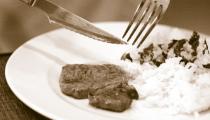Meat
- There is tremendous diversity to the livestock farming in the Mediterranean. Breeds and species common to one area are completely different from other areas. In northern countries, the climate favors better pastures, so it is possible to breed large herds of cattle, whereas in the southern countries, smaller ruminants like goats and sheep are better adapted to drier conditions.
- Shepherding and free-range livestock farming (which today form part of what is known as extensive agriculture) have played a central role in the preservation of the cultural and biological heritage in Mediterranean countries. The grazing of herbivores is one of the oldest and most important factors responsible for the conservation of the ecologically diverse Mediterranean landscape. Animals disperse seeds, recycle organic matter in the soil, help to conserve species of herbs, etc.
- This model of animal husbandry has socio-cultural implications as well. Livestock farming not only provides a livelihood for peoples in rural areas, it shapes their cultures. In the southern and eastern Mediterranean, cultures are deeply influenced by the practice of nomadic shepherding, with people and livestock - sheep, goats, camels, etc. - moving between communal lands in steppes and mountainous regions.
- According to FAO statistics, the production of meat in the Mediterranean has tripled since the 1960s. In 2007, production reached 22,442,637 tons, representing 8,4% of world production. Total consumption has followed a similar trend. The bigger producers are France, Italy and Spain, followed at quite some distance by Egypt and Turkey.
- Per capita consumption varies greatly by country. The biggest "carnivores" are Spain, Malta, Cyprus and Israel, with five times the meat consumption of Muslim countries. There is little to no pork consumption in Israel or Muslim countries, whereas in some countries pork is the most popular meat.
21/06/2011 - 15:40



